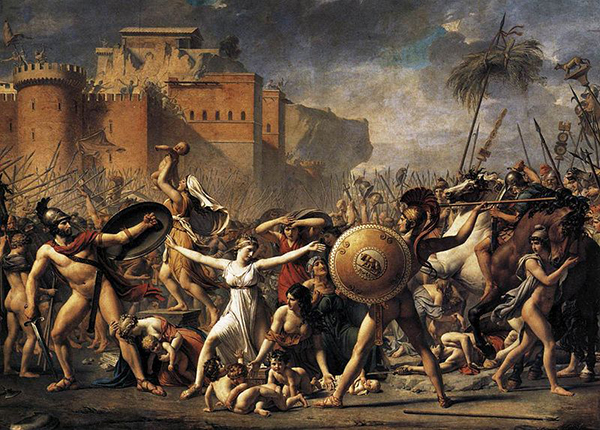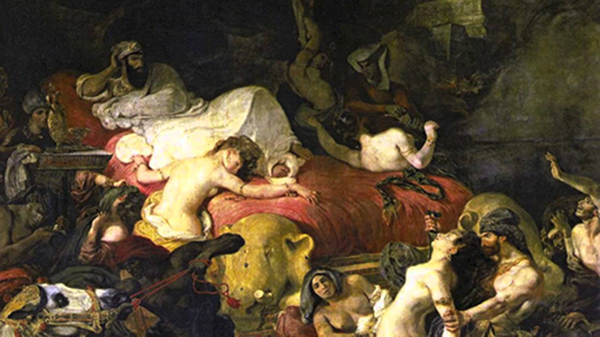Stendhal's Views on Art
From Elizabeth Gilmore Holt, From Classicists to the Impressionists: Art and Architecture in the 19th century (New Haven, Conn.: Yale University Press, 1981), pp.40-42.
Marie Henri Beyle (1783-1842), better known by his pen name "Stendhal" is famous today as the author of novels such as The Red and the Black and The Charterhouse of Parma, but in his own time he was also a prominent art critic. As such he represented early 19th century Romanticism, which emphasized the role of strong emotions and inspiration in the creation of works of art. In the excerpts below are his reactions to some of the works on display at the Salon of 1824, the official art exhibit in Paris sponsored by the French academy. He strongly rejects the classicism represented by Jacques-Louis David, an earlier painter who dominated French painting in the late 18th and very early 19th centuries. (David's 1799 painting, The Intervention of the Sabine Women, which receives particular scorn from Stendhal, may be seen at the bottom of this page.)
To get the full impact of Stendhal's Romanticism, you might compare his comments below with those of the classicist Ingres, from Day 1. These two selections make clear the differences in how the defenders of classicism and of Romanticism defined great art. The Romantics' attack on classicism will help lay the foundations for later experiments in art, such as Impressionism.
ARTICLE 1, AUGUST 31, 1824, Journal de Paris \
We are at the dawn of a revolution in the Fine Arts. The huge pictures composed of thirty nude figures inspired by antique statues and the heavy tragedies in verse in five acts are, without a doubt, very respectable works; but in spite of all that may be said in their favor, they have begun to be a little boring. If the painting of the "Sabines" were to appear today, we would find that its figures were without passion and that in any country it is absurd to march off to battle with no clothes on. "But that is the way it is done in antique basrelief!" [i.e. ancient Greek or Roman figures carved into a wall] cry out the classicist painters, those men who swear by David and who cannot say three words without speaking of style. And what do I care about antique bas-relief! Let us try to do good modern painting. The Greeks liked the nude; we, we never see it, and I will go further and say that it disgusts us.
Without heeding the clamours of the opposite party, I am going to tell the public frankly and simply what I feel about each of the pictures it will honor with its attention. I will give the reasons for my particular point of view. My aim is to make each spectator search his soul, analyze his personal manner of feeling, and come in this manner to form his own opinion, to a way of seeing based on his individual character, his taste, his dominating passions, provided that he has passions, for unfortunately they are necessary in the judgement of art.
ARTICLE 4, SEPTEMBER 12
Throw the most ordinary man into prison, one the least familiar with every idea of art and literature, in a word, one of those ignorant lazybones who are encountered in such large numbers in a vast capital, and as soon as he has recovered from his initial fright, tell him that he will be set free if he is capable of showing at the Salon a nude figure perfectly drawn according to the system of David. You would be astonished to see the prisoner in the experiment reappear in the outside world at the end of two or three years. Correct, scholarly drawing imitated from antiquity as the school of David comprehends it is an exact science like arithmetic, geometry, trigonometry, etc. That is to say, with infinite patience and with the brilliant genius of Bareme, one can arrive in two or three years at a knowledge of the conformation and the exact position of the hundred muscles which cover the human body and be able to reproduce them with a brush. During the thirty years that David's tyrannical government has lasted, the public has been obliged to believe, under penalty of being charged with bad taste, that to have had the patience necessary to acquire the exact science of drawing was to be a genius. . . .
But I return to the prisoner we have thrown into a tower of
Mont San Michel. Tell him: "You will be free when you are capable of depicting in a manner recognizable by the public, the despair of a lover who has just lost his sweetheart,· or the joy of a father who sees the son appear whom he believed to be dead"; and the unfortunate will find himself condemned by this to perpetual imprisonment. This is because, unfortunately for many artists, the passions are not an exact science that the ignorant may master. To be able to paint the passions, they must have been seen, their devouring flames must have been felt. Note well that I do not say that all passionate people are good painters; I say that all great artists have been passionate men. This is equally true in all the arts, from Giorgione dying of love at thirty-three because Morto de Feltre, his student, had stolen his mistress, to Mozart, who died because he imagined that an angel disguised as a venerable old man called him to heaven.
The school of David can only paint bodies; it is decidedly inept at painting souls
Jacques-Louis David, The IIntervention of the Sabine Women (1799) |
Eugène Delacroix, The Death of Sardanapalus (1827) |

